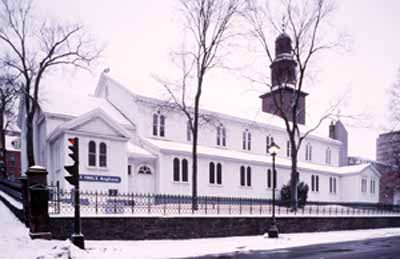St. Paul's Anglican Church National Historic Site of Canada
Halifax, Nova Scotia

Side façade
© Parks Canada Agency / Agence Parcs Canada, 1994.
Address :
1749 Argyle Street, Halifax, Nova Scotia
Recognition Statute:
Historic Sites and Monuments Act (R.S.C., 1985, c. H-4)
Designation Date:
1981-11-13
Dates:
-
1750 to 1750
(Construction)
-
1787 to 1864
(Significant)
-
1812 to 1812
(Significant)
-
1868 to 1868
(Significant)
-
1873 to 1873
(Significant)
-
1926 to 1926
(Significant)
Event, Person, Organization:
-
Charles Inglis, Bishop
(Person)
-
Anglican Church of Canada
(Organization)
Other Name(s):
-
St. Paul's Anglican Church
(Designation Name)
Plaque(s)
Existing plaque: 1749 Argyle Street, Halifax, Nova Scotia
Completed in 1750, St. Paul's was the first church outside Great Britain to be designated as an Anglican cathedral. Between 1787 and 1864 it served as the cathedral church of the See of Nova Scotia. For 96 years St. Paul's was also the official garrison church for the army and navy establishment. The design of the building is based on that of St. Peter's, Vere Street, London, England, by James Gibbs. St. Paul's is the first building erected in the Palladian style in Canada. Despite the addition of wings and chancel, the original wooden frame, pre-cut in Boston, still forms the main body of the church.
Description of Historic Place
Prominently situated in front of the Grand Parade square in the historic heart of Halifax, Nova Scotia, St. Paul’s Anglican Church National Historic Site of Canada is a small, classically-designed wooden church with a gable roof and central steeple. Its design and splendid classical detailing evoke its associations with the 18th-century British establishment of the city. The designation refers to the building on its footprint.
Heritage Value
St. Paul’s Anglican Church was designated a national historic site of Canada in 1981 because: it was the first building erected in the Palladian style in Canada; and, it was the first church outside Great Britain to be designated an Anglican cathedral.
Completed in 1750, St. Paul’s became the cathedral church of the diocese of Nova Scotia from 1787 until 1864 with Charles Inglis as its first bishop. For 96 years, St. Paul’s was also the official garrison church of the local British army and navy establishment. The design of the building probably came from a pattern book and is based on that of St. Peter’s, Vere Street, London, England, by James Gibbs. As such, St. Paul’s is an early, if evolutionary, example of the Palladian style in Canada. Despite its 1812 expansion and the later addition of side aisles (1868) and chancel (1873), the original wooden frame (pre-cut in Boston) still forms the main body of the church. In 1926 the steeple was clad in copper and the north porch rebuilt. The church was meticulously restored in 1984-1990.
Sources: Historic Sites and Monuments Board of Canada, Minutes, November 1981, June 1984, and November 1986; Commemorative Integrity Statement, 2000.
Character-Defining Elements
Key elements of this site which contribute to its heritage value include: those aspects of the building which speak to its qualities as an early Palladian-style church in Canada, namely the original timber-framing, its fundamentally classical design featuring symmetrical elevations, the rectangular volume with gable roof and staged polygonal steeple over the main entry; its classical detailing including corner quoins, pediments, Palladian window, and longitudinal interior layout with central nave and entry facing the altar, three-sided gallery; its simple, plastered interior finish; the evolutionary nature of its design, particularly those aspects of the building which are sympathetic to the original Palladian design in their form and materials, namely the 1812 additions, the side aisles, and the 1873 chancel; those aspects of the building which speak to its former role as an Anglican cathedral, namely its prominent setting at one end of the Grand Parade in the centre of Halifax, and the marble memorial to Bishop Charles Inglis, the first Bishop of Nova Scotia.